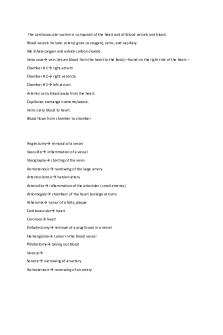4. Cardiovascular System 4 outline exam PDF

| Title | 4. Cardiovascular System 4 outline exam |
|---|---|
| Author | Hanann Ali |
| Course | Human Anatomy and Physiology I |
| Institution | University of Ottawa |
| Pages | 2 |
| File Size | 90 KB |
| File Type | |
| Total Downloads | 113 |
| Total Views | 174 |
Summary
Cardiovascular system 4 outline of the chatter and what work needs to be covered for the exams and assignments....
Description
4. Cardiovascular System (9 lectures) 4.1. Blood 4.2. The Heart 4.3. Blood vessels and hemodynamics 4.3.1. Compare and contrast the structure of the walls of arteries, capillaries and veins 4.3.1.1. Define arteries and veins in terms of direction of blood flow 4.3.1.2. From inside to outside, list the 3 tunics of blood vessels and briefly describe their structural composition; indicate what blood vessels would have fewer than these 3 layers in their walls 4.3.2. Compare the 3 types of arterial vessels 4.3.2.1. Distinguish between elastic (conducting) and muscular (distributing) arteries 4.3.2.2. Define and briefly describe the anatomy of arterioles 4.3.3. Define “microcirculation” and compare the 3 types of capillaries in terms of structure, permeability and localization\ 4.3.3.1. Define/describe the following terms/structures: microcirculation, vascular shunt, terminal arteriole, metarteriole, thoroughfare channel, precapillary sphincter, postcapillary venule 4.3.3.2. List the 3 types of capillaries and give examples of tissues in which you would expect to find each type of capillary 4.3.4. Describe the structure and functions of the venules and veins 4.3.4.1. Contrast the typical anatomy of the wall of a vein with that of an artery 4.3.4.2. Describe 2 structural adaptations of veins that promote blood return to the heart 4.3.4.3. Outline the role of the respiratory system in promoting venous return 4.3.5. Illustrate the changes in blood pressure throughout the various vessels of the circulatory system 4.3.5.1. Define blood flow, blood pressure, resistance, peripheral resistance 4.3.5.2. Plot changes in blood pressure as blood travels through the circulatory system from the aorta to the vena cava 4.3.6. Explain the factors that affect resistance and justify the importance of arterioles in the control of peripheral resistance 4.3.6.1. List and briefly describe 3 parameters that can influence resistance to blood flow 4.3.6.2. Justify the association between arterioles and the largest drop in blood pressure 4.3.7. Describe the role of elastic arteries in promoting continuous blood flow throughout systole and diastole 4.3.8. Define systolic and diastolic arterial pressure, pulse pressure and mean arterial pressure 4.3.8.1. Express pulse pressure in terms of systolic and diastolic pressure 4.3.8.2. Express mean arterial pressure (MAP) in terms of diastolic pressure and pulse pressure 4.3.9. Identify and justify the value for mean capillary blood pressure 4.3.9.1. Be aware of blood pressure in capillary beds 4.3.9.2. Indicate 2 reasons why capillary beds are low pressure systems 4.3.10. Express blood pressure in terms of cardiac output and peripheral resistance 4.3.10.1. Define pulse; explain how pulse and arterial blood pressure are measured 4.3.10.2. Define hypotension and hypertension 4.3.11. Describe the short-term neural and chemical mechanisms for the regulation of blood pressure 4.3.11.1. Define vasomotor tone; describe the location and role of the vasomotor centre in the short-term regulation of blood pressure 4.3.11.2. Outline the roles of Baroreceptors and various chemical signals in the short-term regulation of blood pressure
4.3.11.3. Briefly indicate the roes of higher brain centres in the short-term regulation of blood pressure 4.3.12. Briefly summarize the role of the kidneys in the long-term regulation of blood pressure 4.3.13. Define and explain the mechanisms of autoregulation with regard to local blood flow 4.3.13.1. Define “resting vascular tone” and explain how this normal physiological mechanism permits redistribution of blood flow among various tissues and organs 4.3.13.2. Describe briefly the metabolic and myogenic local regulation of blood flow 4.3.14. Explain the forces that act to influence capillary exchange 4.3.14.1. Describe capillary blood flow using the following terms: precapillary sphincter, vasomotion, arteriovenous shunt 4.3.14.2. Describe the 3 types of exchange occurring in capillary beds; your description should demonstrate understanding of the hydrostatic and oncotic forces acting at the arterial versus the venous ends of capillaries 4.3.15. Identify the principal arteries and veins of the cardiovascular system 4.3.15.1. You are responsible for the main arteries and veins up to the level of the wrist and the ankle, to each organ and to the brain (up to and including the circle of Willis; work with Tables 19.4-19.13)...
Similar Free PDFs

Cardiovascular system
- 2 Pages

Cardiovascular System
- 2 Pages

Cardiovascular System
- 12 Pages

Module 5 - Cardiovascular System
- 2 Pages

Cardiovascular System Quiz
- 4 Pages

Cardiovascular System 2
- 13 Pages

Cardiovascular System MCQ
- 9 Pages

Cardiovascular System Lecture
- 10 Pages

Cardiovascular System Worksheet
- 5 Pages

Chapter 11 Cardiovascular System
- 4 Pages

Chapter 4 Textbook Outline
- 12 Pages

Exam 4 – Lect 4 - Damiani
- 2 Pages
Popular Institutions
- Tinajero National High School - Annex
- Politeknik Caltex Riau
- Yokohama City University
- SGT University
- University of Al-Qadisiyah
- Divine Word College of Vigan
- Techniek College Rotterdam
- Universidade de Santiago
- Universiti Teknologi MARA Cawangan Johor Kampus Pasir Gudang
- Poltekkes Kemenkes Yogyakarta
- Baguio City National High School
- Colegio san marcos
- preparatoria uno
- Centro de Bachillerato Tecnológico Industrial y de Servicios No. 107
- Dalian Maritime University
- Quang Trung Secondary School
- Colegio Tecnológico en Informática
- Corporación Regional de Educación Superior
- Grupo CEDVA
- Dar Al Uloom University
- Centro de Estudios Preuniversitarios de la Universidad Nacional de Ingeniería
- 上智大学
- Aakash International School, Nuna Majara
- San Felipe Neri Catholic School
- Kang Chiao International School - New Taipei City
- Misamis Occidental National High School
- Institución Educativa Escuela Normal Juan Ladrilleros
- Kolehiyo ng Pantukan
- Batanes State College
- Instituto Continental
- Sekolah Menengah Kejuruan Kesehatan Kaltara (Tarakan)
- Colegio de La Inmaculada Concepcion - Cebu



